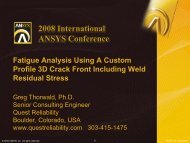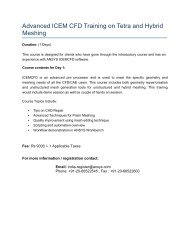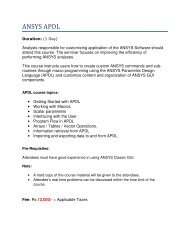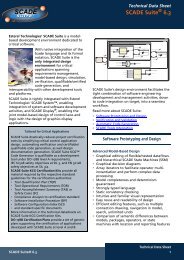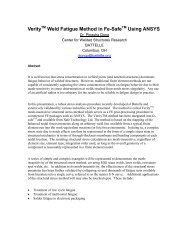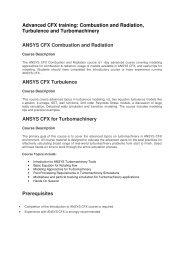Simulation - ANSYS
Simulation - ANSYS
Simulation - ANSYS
You also want an ePaper? Increase the reach of your titles
YUMPU automatically turns print PDFs into web optimized ePapers that Google loves.
with increasing frequency. These materials<br />
do not follow the linear elastic assumption of<br />
stress–strain relationships. Structures made<br />
with these materials may undergo appreciable<br />
changes in geometric shape before<br />
failure. Without accounting for this material<br />
behavior, it can be impossible to extract<br />
meaningful and accurate information from<br />
their simulations.<br />
In the past, nonlinear analysis was associated<br />
with heavy investment in training,<br />
Turbomachinery Coupling<br />
Bibby Transmissions Group — a long-time <strong>ANSYS</strong> DesignSpace user — has<br />
been a world leader for many years in the design and manufacture of couplings<br />
for use in industrial markets. The company’s high-speed disc couplings, designed<br />
by its TurboFlex division, have been a popular choice for transmission couplings<br />
among the power, chemical, steel and water treatment industries.<br />
Engineers at Bibby found that with linear analysis assumptions, material<br />
yielding occurred around clearance holes where the flexible coupling was<br />
mounted and also when the coupling was rotating near its operating speed.<br />
Knowing that they were not capturing material behaviors related to contact and<br />
preloading conditions, engineers at Bibby felt a need to model the material plasticity<br />
and calculate plastic strains and deflection. This analysis was undertaken to<br />
ensure that the loading-induced plasticity was localized and did not induce<br />
global failure for the coupling. The simulation required nonlinear modeling of contact<br />
in which the couplings used an interference fit, material behavior for the hub<br />
and spacer, and bolt preloading for the couplings.<br />
Bibby engineers successfully set up this model within the <strong>ANSYS</strong> Workbench<br />
<strong>Simulation</strong> tool using the previously mentioned nonlinearities and were able<br />
to accurately predict the observed behavior. In addition, they were able to<br />
identify operating speed — not torque as had been previously believed — as the<br />
dominant factor that influenced the observed plastic deformation. This valuable<br />
information could not have been obtained by physical testing alone.<br />
Thanks to Wilde FEA Ltd. for assistance with this article.<br />
The assembly model includes pretension bolted<br />
joints and BISO material for the hub and spacer.<br />
resources and manpower. For many, the<br />
software appeared cumbersome, challenging<br />
and intimidating. It was acceptable<br />
and often preferable to get by with physical<br />
testing alone. That is not the case today,<br />
however. Nonlinear structural simulation is<br />
no longer an intimidating tool, but rather<br />
one that <strong>ANSYS</strong> has made available to all<br />
engineers by fusing its complex physics<br />
into an easy-to-use interface in the <strong>ANSYS</strong><br />
Workbench environment. ■<br />
The von Mises stress exceeds the yield<br />
limit of 700 MPA, and yet it is localized.<br />
PRODUCTS & TECHNOLOGY: NONLINEAR<br />
Medical check valve<br />
“Through the <strong>ANSYS</strong> Workbench<br />
platform, we have a tool that<br />
allows us to increase the per-<br />
formance of our products. Drastic<br />
reductions in weights and inertia<br />
of the couplings have been<br />
achieved without compromising<br />
the strength of the unit. Lateral<br />
vibration of couplings is now<br />
being estimated to a level of<br />
confidence previously unattain-<br />
able without days of computation<br />
and cost.”<br />
— Ron Cooper, Technical Director<br />
Bibby Transmission, U.K.<br />
www.ansys.com <strong>ANSYS</strong> Advantage • Volume II, Issue 2, 2008 25





